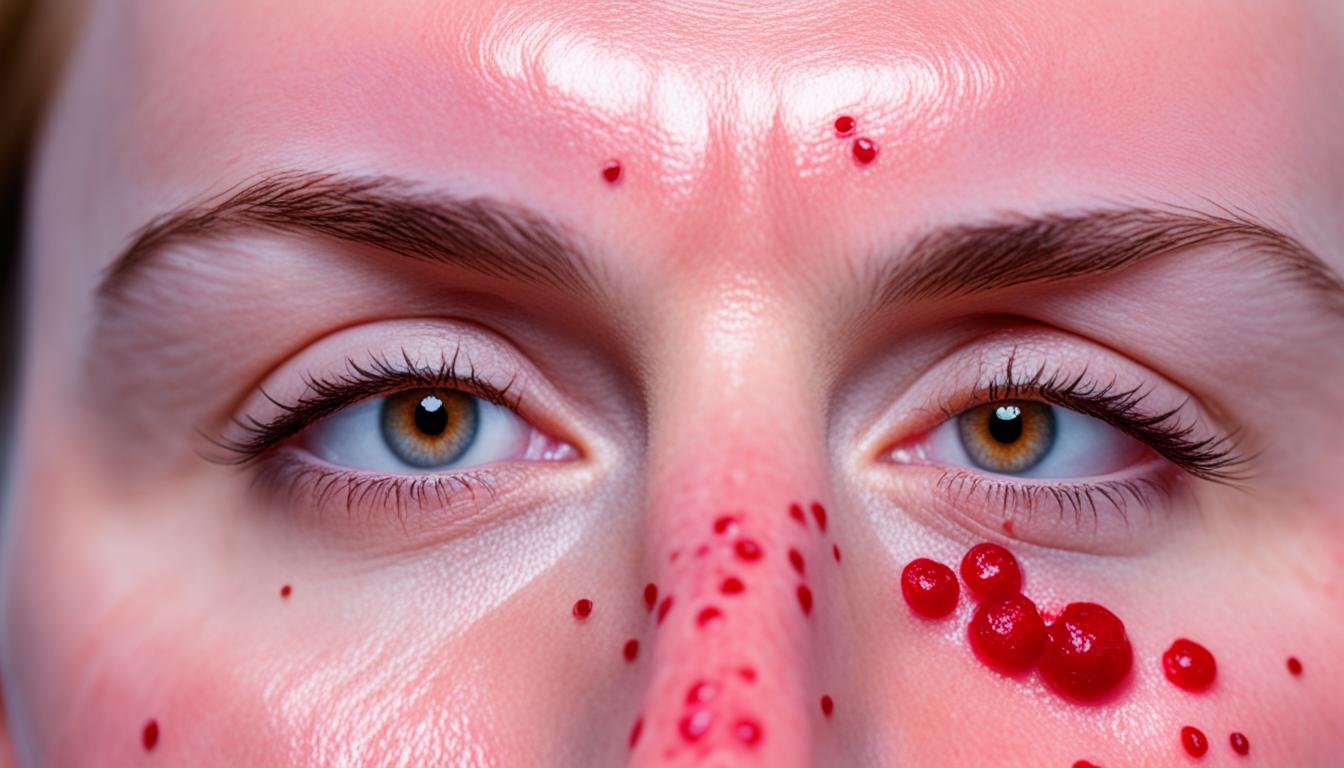Have you ever noticed red, swollen bumps on your skin? These bumps, known as acne or pimples, are quite common. They often start in the teenage years but can stick around into adulthood.
The primary culprit behind pimples is excessive sebum, an oily substance. This overproduction blocks your skin’s pores. If these clogged pores get infected with the bacteria Propionibacterium acnes, a response happens that makes them look swollen and red.
Pimples are not just one type of bump; they come in many shapes. You may see whiteheads, blackheads, or even bigger bumps called cysts. Things like changes in hormones, your family’s history, and infections may play a role in causing pimples.
Key Takeaways:
- Pimples, or acne, is a common skin condition affecting both teenagers and adults.
- Overproduction of sebum and bacterial infection are key factors in pimple formation.
- Pimples can manifest in various forms, including whiteheads, blackheads, and cysts.
- Understanding the causes and symptoms of pimples is crucial for effective diagnosis and treatment.
- Stem cell therapy is an emerging treatment option for pimples.
Stem Cell Therapy for Pimples – Regenerating Skin and Eliminating Blemishes
Stem cell therapy is a new way to improve skin and treat pimples. It uses stem cells to help renew the skin and reduce blemishes. This method is a big step in treating pimples.
What makes this method special are the mesenchymal stem cells. They can become different cell types, great for fixing skin. With micro needling, they can reach deep into the skin. This helps make more collagen and renew the skin.
This method is gentle but it works well on pimple scars of different types. It also helps with dark spots that come with pimples, making the skin tone more even.
Stem cells also make the skin stronger against the bacteria causing pimples. They boost the body’s natural defenses. This does not only make the skin look better but also keeps pimples from coming back.
Seeing a dermatologist before starting any skin treatment is important. They can give advice that fits you, making the treatment work better. With their help, you can keep your skin looking good over time.
The combination of stem cell therapy and good dermatologist advice is powerful against pimples. It treats the main causes of pimples and improves skin health overall.
Case Study: The Efficacy of Stem Cell Therapy in Pimple Treatment
Let’s look at a case study to see how well stem cell therapy works on severe pimples.
| Patient | Severity of Pimples | Treatment Duration | Results |
|---|---|---|---|
| Sophia | Moderate | 4 months | Significant reduction in pimple breakouts and scar visibility. Improved skin texture and overall complexion. |
| Eric | Severe | 6 months | Dramatic improvement in pimple breakouts, scarring, and hyperpigmentation. Noticeable rejuvenation and tightening of the skin. |
| Lily | Mild | 3 months | Minimal pimple breakouts, faded scars, and even skin tone. Enhanced skin elasticity and radiance. |
This study shows stem cell therapy with good skincare can do a lot for pimples. People see big changes in their skin, but the time it takes can vary.
Stem cell therapy is a big step in treating pimples because it fights them and helps the skin heal. With a dermatologist’s advice and stem cell therapy, anyone can have clearer and healthier skin.
Future Directions in Pimple Treatment and Prevention
Ongoing acne research is bringing in new ways to treat and prevent pimples. Scientists are looking at new treatments. They’re also trying to find out how pimples form.
They are studying different types of the Propionibacterium acnes bacteria. Knowing more about these bacteria could lead to better treatment. This could help find solutions that work more effectively.
They’re also looking at ways to reduce swelling. This could help stop pimples before they start. Natural ingredients are being studied for their ability to help the skin heal.
The skincare world is changing fast. Now, treatments are more personalized. This means they are made to fit each person’s skin needs, improving results.
Thanks to acne research and new technology, better treatments are coming. This offers hope to those who want clearer, healthier skin. The future of fighting pimples looks promising.

